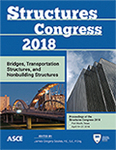Structures Congress 2018
Numerical Analysis of AFRP Reinforced Concrete Columns with Replaceable Structural Fuses as Energy Dissipaters under Cyclic Loading
Publication: Structures Congress 2018: Bridges, Transportation Structures, and Nonbuilding Structures
ABSTRACT
Fiber-reinforced polymer (FRP) bars are gaining increased use in the construction market as a replacement to steel reinforcement for concrete structures. However, their use as compression members is limited due to their mechanical properties, typically low flexural rigidity, so that local buckling may occur at relatively low stress levels. Their premature rupture in RC columns could be eliminated by enhancing the columns’ response elastically and concentrating damage to the externally installed, replaceable post-tensioned structural fuses. This paper is part of a larger numerical and experimental investigation to develop and validate design methods for a rocking Aramid fiber reinforced polymer reinforced concrete column. The numerical study, implemented using the Extreme Loading for Structures (ELS) software, consists of a total of thirteen columns. The columns were subjected to axial load followed by cyclic lateral load up to failure to examine the effectiveness of the rocking connection and overall response. The effect of key variables such as longitudinal bar ratio, structural fuse sizes and tie spacing was investigated. Ductility and energy dissipation gains of the rocking AFRP RC columns were compared to that of the conventionally reinforced steel column, and expected performance of the rocking connection was achieved.
Get full access to this article
View all available purchase options and get full access to this chapter.
ACKNOWLEDGEMENT
The authors gratefully acknowledge sponsors of this research the National Science Foundation (NSF HBCU-UP Grant #1238808).
REFERENCES
AWS, D. (2006). D1. 1/D1. 1M-Structural Welding Code-Steel. American Welding Society.
ACI Committee 440. (2007). Guide for the Design and Construction of Structural Concrete Reinforced with FRP Bars. American Concrete Institute.
Burningham, C. A., Pantelides, C. P., & Reaveley, L. D. (2015). Repair of reinforced concrete deep beams using post-tensioned CFRP rods. Composite Structures, 125, 256-265.
Chinaka, E, Shokouhian, M, Efe, S, Head, M, “Evaluation of bond strength for AFRP reinforcing bars in columns with self-consolidating concrete” in Structures Congress 2017, Denver, April 6-8.
ELS®. Extreme loading for structures technical manual. Applied science International, LLC. V.2.2; 2006
Hewes, J. T., & Priestley, M. N. (2002). Seismic design and performance of precast concrete segmental bridge columns (No. SSRP-2001/25).
Ibrahim, A. M., Fahmy, M. F., & Wu, Z. (2016). 3D Finite Element Modeling of Bond-Controlled Behavior of Steel and Basalt FRP-Reinforced Concrete Square Bridge Columns under Lateral Loading. Composite Structures.
Jeong, H. I., Sakai, J., and Mahin, S. A. (2008). “Shaking Table Tests and Numerical Investigation of Self-Centering Reinforced Concrete Bridge Columns.” Pacific Earthquake Engineering Research Center, Rep. No. PEER 2008/06, University of California, Berkeley, Berkeley, California.
Kara, I. F., and Ashour, A. F. (2012). Flexural performance of FRP reinforced concrete beams. Composite Structures, 94(5), 1616-1625.
Kurama, Y. C., and Shen, Q. (2004). Posttensioned hybrid coupled walls under lateral loads. Journal of Structural Engineering, 130(2), 297-309.
Larkin, A. S., Sanders, D. H., & Saiidi, M. S. (2012). Unbonded Prestressed Columns for Earthquake Resistance. In Masters Abstracts International (Vol. 50, No. 06).
Mander, J. B., & Cheng, C. T. (1997). Seismic resistance of bridge piers based on damage avoidance design. In Technical Report NCEER (Vol. 97). US National Center for Earthquake Engineering Research (NCEER).
Osorio, L. I., Paultre, P., Eid, R., & Proulx, J. (2014). Seismic behavior of synthetic fiber-reinforced circular columns. ACI Structural Journal, 111(1), 189.
Ou, Y. C., Wang, P. H., Tsai, M. S., Chang, K. C., & Lee, G. C. (2009). Large-scale experimental study of precast segmental unbonded posttensioned concrete bridge columns for seismic regions. Journal of structural engineering, 136(3), 255-264.
Palermo, A., Pampanin, S., & Marriott, D. (2007). Design, modeling, and experimental response of seismic resistant bridge piers with posttensioned dissipating connections. Journal of Structural Engineering, 133(11), 1648-1661.
Park, R. (1989). Evaluation of ductility of structures and structural assemblages from laboratory testing. Bulletin of the New Zealand National Society for Earthquake Engineering, 22(3), 155-166.
Perez, F. J., Pessiki, S., & Sause, R. (2004). Seismic design of unbonded post-tensioned precast concrete walls with vertical joint connectors. PCI journal, 49(1), 58-79.
Maekawa, K., & Okamura, H. (1983). The deformational behavior and constitutive equation of concrete using the elasto-plastic and fracture model. Journal of the Faculty of Engineering. University of Tokyo. Series B, 37(2), 253-328.
Maekawa, K., & Qureshi, J. (1997). Stress transfer across interfaces in reinforced concrete due to aggregate interlock and dowel action. Doboku Gakkai Ronbunshu, 1997(557), 159-172.
Ristic, D., Yamada, Y., & Iemura, H. (1986). Stress-strain based modeling of hysteretic structures under earthquake induced bending and varying axial loads. Research Rep. No. 86-ST, 1.
Tagel-Din, H. (2009). High fidelity modeling of building collapse with realistic visualization of resulting damage and debris using the applied element method. Rep. No. HDTRA1-09-P-0006, Defense Threat Reduction Agency (DTRA), Washington, DC.
Tobbi, H., Farghaly, A. S., & Benmokrane, B. (2012). Concrete columns reinforced longitudinally and transversally with glass fiber-reinforced polymer bars. ACI Structural Journal, 109(4), 551.
Yamashita, R., & Sanders, D. (2005). Shake Table Testing and an Analytical Study of an Unbonded Prestressed Hollow Concrete Columns Constructed with Precast Segments (Doctoral dissertation, University of Nevada, Reno).
Information & Authors
Information
Published In
Structures Congress 2018: Bridges, Transportation Structures, and Nonbuilding Structures
Pages: 317 - 337
Editor: James Gregory Soules, CB&I
ISBN (Online): 978-0-7844-8133-2
Copyright
© 2018 American Society of Civil Engineers.
History
Published online: Apr 17, 2018
Authors
Metrics & Citations
Metrics
Citations
Download citation
If you have the appropriate software installed, you can download article citation data to the citation manager of your choice. Simply select your manager software from the list below and click Download.
